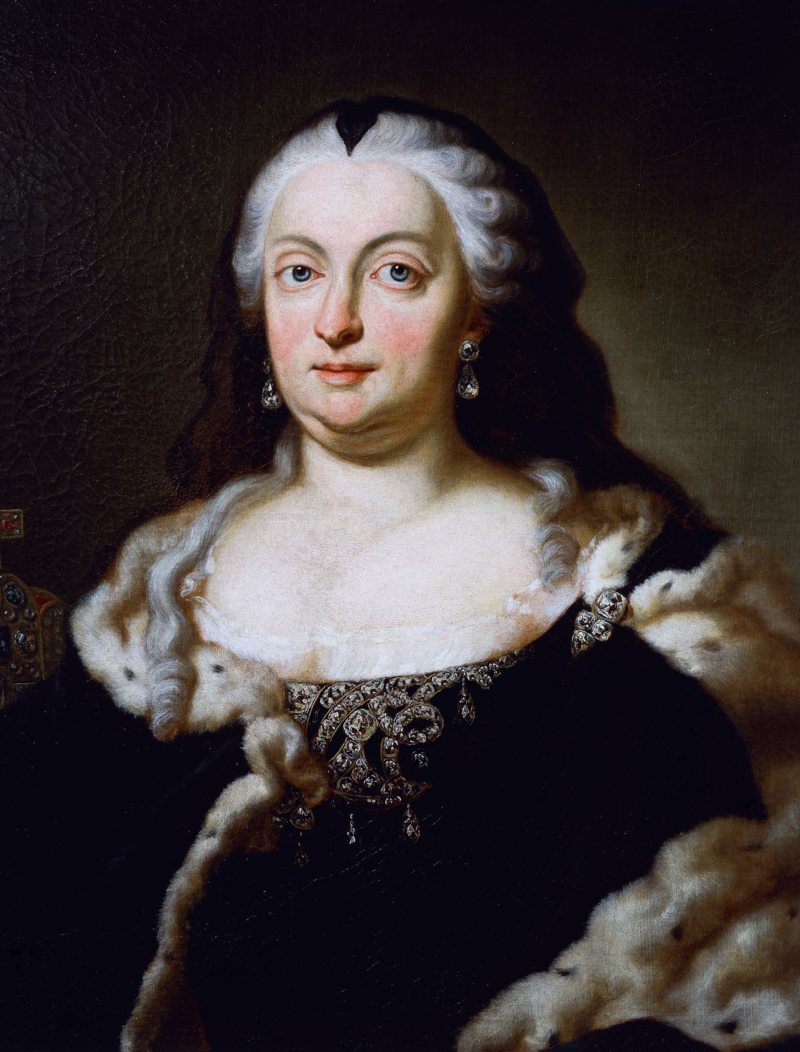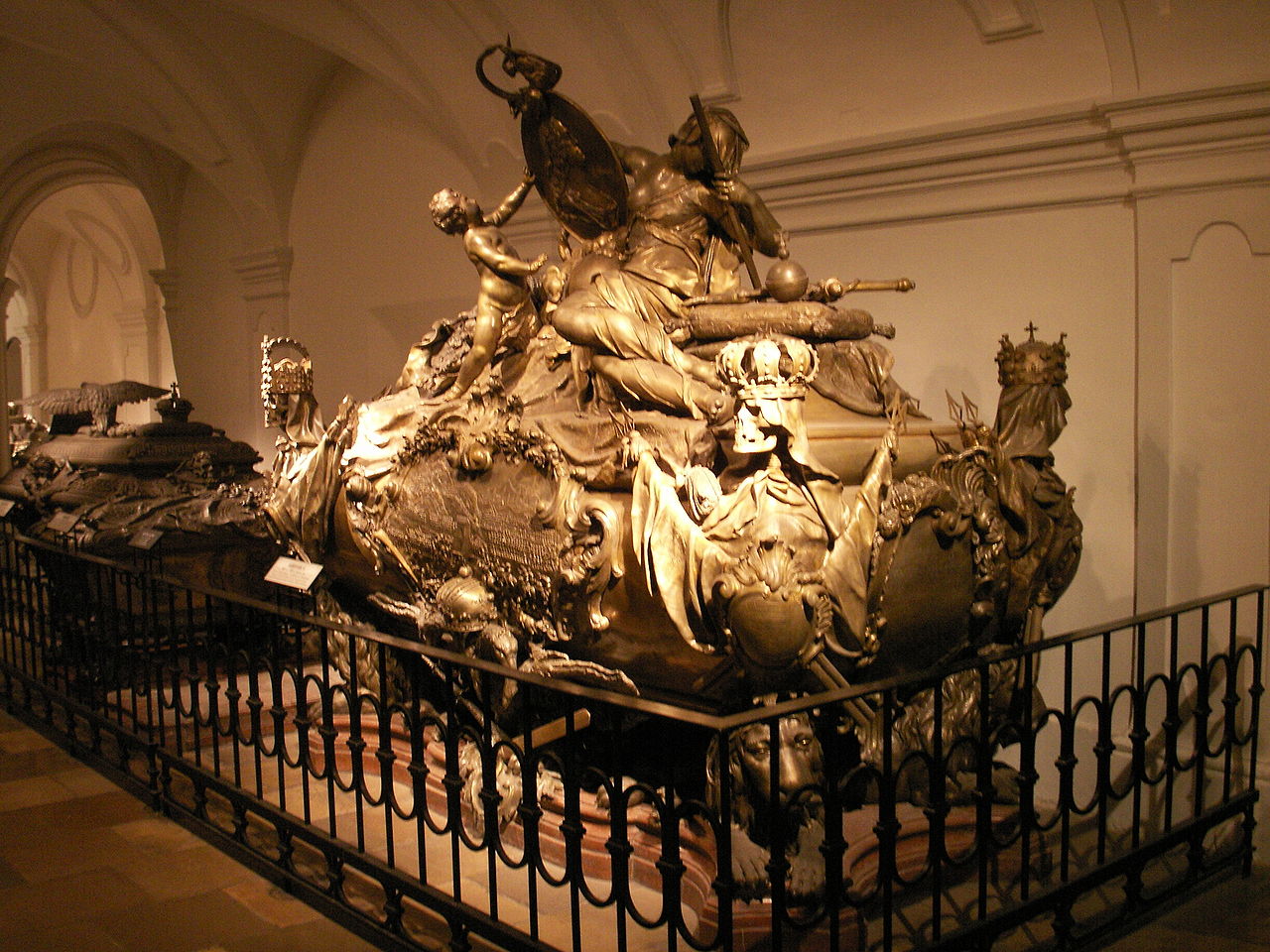by Susan Flantzer
© Unofficial Royalty 2023
The Holy Roman Empire was a limited elective monarchy composed of hundreds of kingdoms, principalities, duchies, counties, prince-bishoprics, and Free Imperial Cities in central Europe. The Holy Roman Empire was not really holy since, after Holy Roman Emperor Charles V in 1530, no emperors were crowned by the pope or a bishop. It was not Roman but rather German because it was mainly in the regions of present-day Germany and Austria. It was an empire in name only – the territories it covered were mostly independent each with its own rulers. The Holy Roman Emperor directly ruled over only his family territories, and could not issue decrees and rule autonomously over the Holy Roman Empire. A Holy Roman Emperor was only as strong as his army and alliances, including marriage alliances, made him, and his power was severely restricted by the many sovereigns of the constituent monarchies of the Holy Roman Empire. From the 13th century, prince-electors, or electors for short, elected the Holy Roman Emperor from among the sovereigns of the constituent states.
Frequently but not always, it was common practice to elect the deceased Holy Roman Emperor’s heir. The Holy Roman Empire was an elective monarchy. No person had a legal right to the succession simply because he was related to the current Holy Roman Emperor. However, the Holy Roman Emperor could and often did, while still alive, have a relative (usually a son) elected to succeed him after his death. This elected heir apparent used the title King of the Romans.
Learn more at Unofficial Royalty: What was the Holy Roman Empire?
********************

Maria Joseph of Bavaria, Holy Roman Empress; Credit – Wikipedia
Princess Maria Josepha of Bavaria was the second of the two wives of Joseph II, Holy Roman Emperor who also was the ruler of the Habsburg hereditary lands. Maria Josepha Antonia Walburga Felizitas Regula was born on March 20, 1739, in Munich, then in the Electorate of Bavaria, now in the German state of Bavaria. She was the seventh of the seven children and the youngest of the five daughters of Karl VII, Holy Roman Emperor, also Karl I, Elector of Bavaria, and Archduchess Maria Amalie of Austria. Maria Josepha’s paternal grandparents were Maximilian II Emanuel, Prince-Elector of Bavaria and his second wife Teresa Kunegunda Sobieska. Her maternal grandparents were Joseph I, Holy Roman Emperor and Wilhelmine Amalie of Brunswick-Lüneburg

Two of Maria Josepha’s siblings, her father’s successor Maximilian III Joseph, Elector of Bavaria and Joseph Ludwig; Credit – Wikipedia
Maria Josepha had six elder siblings but only three survived to adulthood
- Princess Maximiliana Maria of Bavaria (born and died 1723)
- Princess Maria Antonia of Bavaria (1724 – 1780), married Friedrich Christian, Elector of Saxony, had eight children
- Princess Theresa Benedicta of Bavaria (1725 – 1743), died in her teens from smallpox
- Maximilian III Joseph, Elector of Bavaria (1727 – 1777), married Maria Anna Sophia of Saxony, no children
- Prince Joseph Ludwig of Bavaria (1728 – 1733), died in childhood
- Princess Maria Anna Josepha of Bavaria (1734 – 1776), married Ludwig Georg, Margrave of Baden-Baden, no children
Archduke Joseph of Austria, the future Joseph II, Holy Roman Emperor, was the eldest son of Archduchess Maria Theresa of Austria, the only woman to be ruler of the Habsburg hereditary lands in her own right. His father was born Prince François Étienne of Lorraine. Maria Theresa had arranged for her husband to be elected Holy Roman Emperor as Franz I but she wielded the real power and Joseph’s father was content to leave the act of reigning to his wife.
In the fall of 1763, there was an outbreak of smallpox in and around Vienna, and IIsabella of Parma, Archduchess of Austria, the pregnant wife of Archduke Joseph of Austria, the future Joseph II, Holy Roman Emperor, became ill with smallpox. Isabella’s high fever induced labor three months early, and on November 22, 1763, she gave birth to a second daughter. The baby was baptized Maria Christina, as Isabella requested, but died the same day. Five days later, a month short of her 22nd birthday, Isabella died from smallpox. Joseph was devastated by Isabella’s death and never fully recovered. In a letter to Isabella’s father, Joseph wrote: “I have lost everything. My adorable wife and only friend is no more. (…) What a frightful separation! Can I survive it? Yes, and only to be unhappy all my life. (…) There is nothing I will enjoy ever again.”
Joseph did not want to marry again after Isabella’s death but his mother wanted him to provide a male heir. Some overtures were made to Isabella’s younger sister Maria Luisa of Parma but she was already promised to the future Carlos IV, King of Spain. At his mother’s insistence, Joseph married again to his second cousin Maria Josepha of Bavaria. Joseph did not find Maria Josepha physically attractive. After seeing her for the first time, he described her in a letter: “Her figure is short, thickset, and without a vestige of charm. Her face is covered with spots and pimples. Her teeth are horrible.”

Maria Josepha’s husband Joseph in 1765, the year of their marriage; Credit – Wikipedia
A proxy marriage was held in Munich on January 13, 1765, and then 23-year-old Joseph and 25-year-old Maria Josepha were married in person on January 25, 1765, at the Schönbrunn Palace in Vienna. Holy Roman Emperors could and often did, while still alive, have a relative (usually a son) elected to succeed them after their death. The elected heir apparent used the title King of the Romans. In 1764, Joseph was elected and crowned King of the Romans and so Maria Josepha’s new title was Queen of the Romans

Maria Josepha as Holy Roman Empress, circa 1765; Credit – Wikipedia
During his unsuccessful marriage to Maria Josepha of Bavaria, Joseph’s father Franz I, Holy Roman Emperor died suddenly of a stroke or heart attack on August 18, 1765, at the age of 56, in his carriage while returning from the opera in Innsbruck, Austria. Since Joseph had been elected and crowned King of the Romans, the title of the elected heir to the Holy Roman Emperor, Joseph became Holy Roman Emperor although his mother Maria Theresa continued to wield the real power. On September 17, 1765, Joseph was elevated by his mother Maria Theresa to be her co-regent in the Habsburg hereditary lands. Maria Josepha, of course, held the female counterparts of Joseph’s titles.
Maria Josepha’s state of health led her and others to believe that she was pregnant. Joseph never loved Maria Josepha and the marriage was probably never consummated. Joseph avoided sharing a bedroom and even had their shared balcony in Schönbrunn Palace partitioned off so he would not have to see Maria Josepha. In a letter to his brother Leopold, Joseph wrote: As for my empress, there is no change. She has no illness but considerable disturbance. She [Josepha] may be pregnant though without the slightest swelling. I just don’t understand it, and I console myself with the happy life I lead as a bachelor husband.”
Maria Josepha loved Joseph despite his frigid behavior toward her. She was naturally timid, always felt inferior, and trembled and turned pale when she was in Joseph’s presence. Joseph’s father had been the only family member who gave Maria Josepha any support and with his death, that support was gone.
Tomb of Maria Josepha of Bavaria, Holy Roman Empress; Credit – By Krischnig at German Wikipedia – Own work., Public Domain, https://commons.wikimedia.org/w/index.php?curid=5557276
A severe smallpox epidemic broke out in 1767, and Maria Josepha came down with the disease. Although Joseph, who had survived smallpox at an earlier time, had nursed his first wife Isabella as she was dying from smallpox, he did not visit Maria Josepha while she was ill. Her mother-in-law Maria Theresa, did and also caught the disease, but she survived. Maria Josepha was not so lucky. On May 28, 1767, a little more than two years after her marriage to Joseph, Maria Josepha, aged 28, died at Schönbrunn Palace in Vienna, Austria. She was interred at the Imperial Crypt in the Capuchin Church in Vienna, Austria
Joseph did have some regrets after Maria Josepha’s death. He told some close friends that he regretted the coldness he had shown to her, and surprisingly, Joseph told Maria Antonia of Bavaria, Electress of Saxony, Maria Josepha’s sister, that his wife had been “for so many reasons worthy of respect”. Despite this, Joseph did not attend Maria Josepha’s funeral and never visited her tomb. Joseph also never married again. He survived Maria Josepha by twenty-three years, dying from tuberculosis, aged 48, on February 20, 1790, in Vienna, Austria.
This article is the intellectual property of Unofficial Royalty and is NOT TO BE COPIED, EDITED, OR POSTED IN ANY FORM ON ANOTHER WEBSITE under any circumstances. It is permissible to use a link that directs to Unofficial Royalty.
Works Cited
- Flantzer, Susan. (2023) Joseph II, Holy Roman Emperor also King of Bohemia, King of Hungary and Croatia, Archduke of Austria, Unofficial Royalty. Available at: https://www.unofficialroyalty.com/joseph-ii-holy-roman-emperor-also-king-of-bohemia-king-of-hungary-and-croatia-archduke-of-austria/ (Accessed: 05 September 2023).
- Flantzer, Susan. (2023) Karl VII, Holy Roman Emperor, Elector of Bavaria, Unofficial Royalty. Available at: https://www.unofficialroyalty.com/karl-vii-holy-roman-emperor/ (Accessed: 05 September 2023).
- Maria Josepha of Bavaria (2023) Wikipedia. Available at: https://en.wikipedia.org/wiki/Maria_Josepha_of_Bavaria (Accessed: 05 September 2023).
- Maria Josepha von Bayern (2023) Wikipedia (German). Available at: https://de.wikipedia.org/wiki/Maria_Josepha_von_Bayern (Accessed: 05 September 2023).
- Wheatcroft, Andrew. (1995) The Habsburgs. London: Viking.
- Wilson, Peter H. (2016) Heart of Europe – A History of the Holy Roman Empire. Cambridge, MA: Harvard University Press.















































